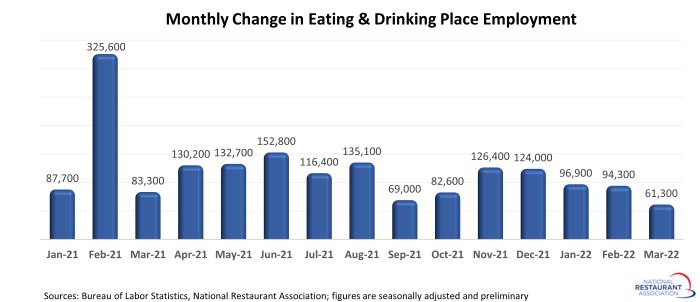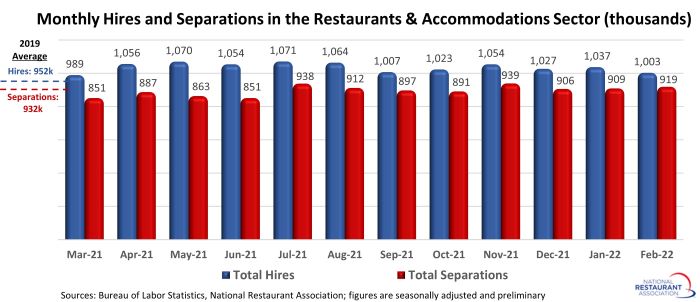Restaurant job growth slowed in the first quarter
Job growth in the restaurant industry slowed during the first quarter of 2022, according to preliminary data from the Bureau of Labor Statistics (BLS). Eating and drinking places* added a net 61,300 jobs in March on a seasonally-adjusted basis, which followed downward-revised gains of less than 100,000 in both January and February.
Although March represented the 15th consecutive month of restaurant job growth, it was also the smallest gain during that period. As a result, the 252,000 restaurant jobs added during the January – March period represented the smallest quarterly increase since the fourth quarter of 2020.
Overall, eating and drinking places remain 820,000 jobs – or 6.6% – below their pre-pandemic staffing levels.

Employees are moving between restaurants
On average during the past 12 months, employers in the restaurants and accommodations sector** hired more than 1 million people each month, according to Job Openings and Labor Turnover (JOLTS) data from BLS. At the same time, an average of 897,000 people left their jobs each month – either by quitting (746,000), layoffs (127,000) or other circumstances (24,000).
The recent churn in the hospitality workforce was not too far removed from pre-pandemic trends. Employers in the restaurants and accommodations sector hired an average of 952,000 people each month during 2019 – or about 86,000 fewer than the average of 1,038,000 people hired during the last 12 months.
Separations are currently running a little behind 2019 levels. An average of 932,000 people left their jobs each month in 2019 – compared to 897,000 during the last 12 months.
Within separations, quits are somewhat elevated compared to pre-pandemic levels. An average of 746,000 people quit their jobs during the last 12 months – up from an average of 692,000 during 2019.
The high number of separations does not mean that a corresponding number of people are leaving the industry each month. If only separations were elevated, that would be the case. The combination of elevated hires and separations means a sizable number of employees are leaving a job at one restaurant for a job at another restaurant.

*Eating and drinking places are the primary component of the total restaurant and foodservice industry, which prior to the coronavirus outbreak employed 12 million out of the total restaurant and foodservice workforce of 15.6 million.
**The hires and separations data presented above are for the broadly-defined Accommodations and Food Services sector (NAICS 72), because the Bureau of Labor Statistics does not report data for restaurants alone.
Read more analysis and commentary from the Association's chief economist Bruce Grindy.